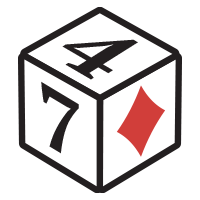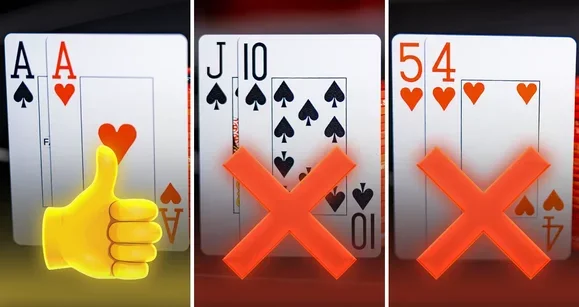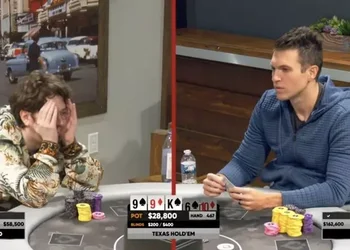Mike Brady: Would you be better off playing like a super tight nit before the flop?
Uri Peleg has coached up some of the world's best high stakes players on their way to winning millions, and he's joining us today to answer this question.
Uri: Hey Mike, what's up? Thanks for having me.
Mike: Should you play like a nit preflop? But let's back up. Why is this even a question, you might be wondering? Let's look at an under the gun opening range at a six-handed table and observe the expected value of several hands.
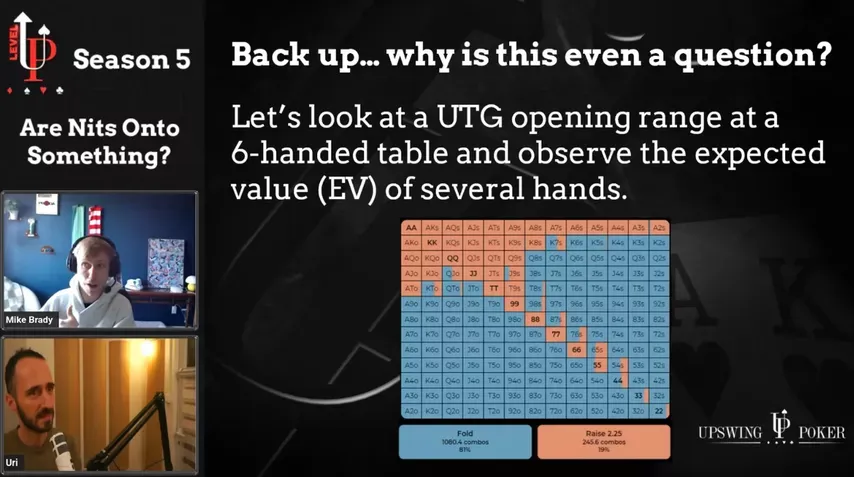
At the top end:
- Pocket Aces make a little over 9 big blinds on average every time you raise with them.
- Pocket Kings make a little over 5 big blinds.
- Pocket Queens make a little over 2 big blinds.
- Ace-King suited makes 1.53 big blinds.
Very powerful! Now let's compare this to the bottom of the raising range:
That’s some really nice expected value with each of these hands.
Now let’s look at the other end of the spectrum — the bottom-of-range EVs.
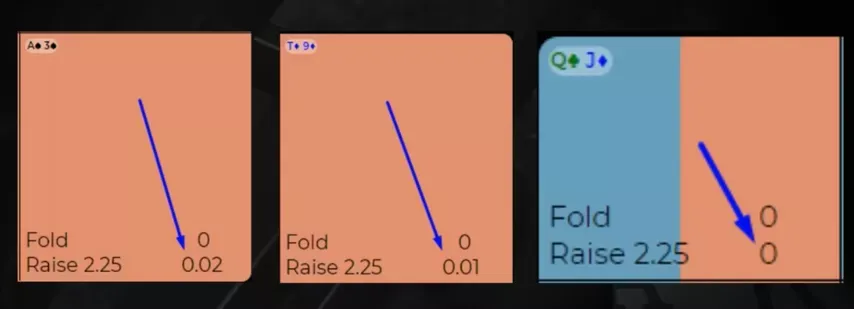
- Ace-Three suited makes 0.02 big blinds per raise.
- Ten-Nine suited makes 0.01 big blinds per raise.
- Queen-Jack offsuit, which is a mixed-frequency raise, makes 0 big blinds on average when you raise with it.
Uri: I guess one thing I would add is that we’re talking about being a nit preflop, but everything we’re saying kind of applies postflop too.
If you looked at the EVs of your hands after the flop, you’d see that a ton of it is concentrated on when you make a set, two pair, or have an overpair.
The structure of poker is always that the top hands capture the majority of the value.
Mike: I guess one thing I would add is that we’re talking about being a nit preflop, but everything we’re saying kind of applies postflop too.
If you looked at the EVs of your hands after the flop, you’d see that a ton of it is concentrated on when you make a set, two pair, or have an overpair.
The structure of poker is always that the top hands capture the majority of the value.
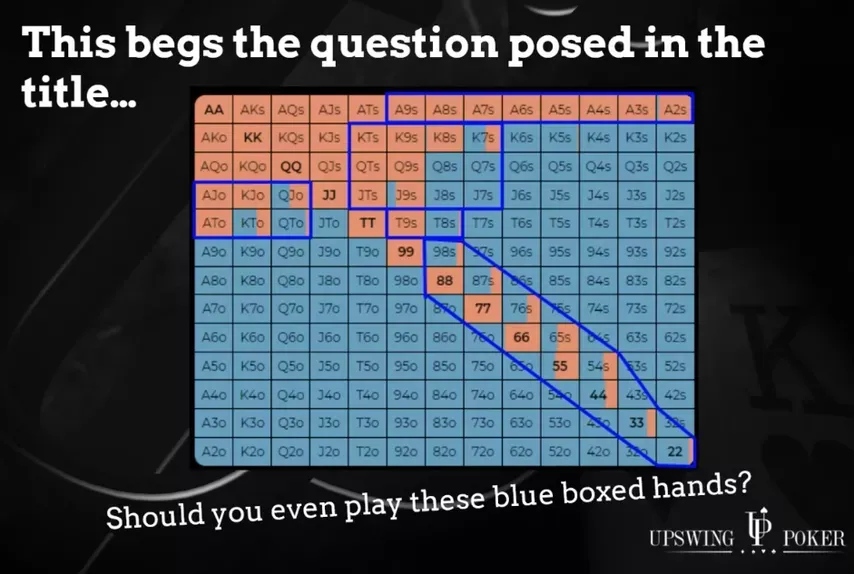
Uri: Okay, so I was asked the question: If a few hands make the majority of the money, why play the rest?
First of all — the rest of the hands do make money, so why not play them, right? Poker is a game of small incremental edges. You don’t have to play them — you can fold them in certain table conditions. Don’t get married to them. If you really have to go to the bathroom and it’s a live game, fold the hand! Recognize how important or unimportant they are.
The second reason is that if you only play the very best hands, people notice. Whether online or live, players will recognize that you’re a nit — and then your good hands will make less money.
So the reason we play the rest of the hands isn’t just so that our good hands make money — it’s because these hands make money. We play them because they’re profitable.
A side effect of playing them is that your range becomes looser, and so your strongest hands start making even more money.
- If I only ever play Aces, I’ll never get action.
- If I play Aces, Kings, Queens, and Ace-King — still probably not getting much action.
- But if I start widening my range a bit more, suddenly people start giving me action.
Your good hands win more than the blinds, you’re tougher to read, and not to mention — it’s more fun!
Mike: You don’t want to allow people who are paying attention to adjust the same way you do. That’s why it’s important to mix in these hands.
And then number three goes hand in hand with number two: playing a looser range helps your strong hands make more money. Your range becomes tougher to read — you might have Six-Five suited, or you might have Aces. That unpredictability makes you much tougher to play against.
Uri: Let me add just a few simple ideas on top of that.
When we say “it’s just seven percent of the money,” imagine if I said, “The rake is just seven percent extra in this game.” Seven percent in poker is a lot. Beating the rake by five percent is amazing. There’s so much back and forth in poker that you can’t afford to give away small edges — not even a few percentage points — as a general approach.
And this testifies to something we talk about often: If everyone were a GTO bot, you could play like a nit and still be fine because everyone else would play perfectly too. But we don’t live in that world. So, we always encourage players to think about things from both directions. You shouldn’t play like a nit — but you also need to understand how to exploit players who do play like nits.
There was a live game I played in recently with a guy who never, ever bluffed. Then one day he told me he watched a podcast with Eli Elezra, said he’d been inspired, and suddenly made this huge bluff and showed it down. My thought was, “Damn, I can’t just auto-fold to this guy anymore.” I paid off a big stack, and of course, he had it.
These little adjustments happen on every level of poker. You want to be the unpredictable player — the one who can bluff, loosen up, three-bet, and four-bet when necessary.

And remember: you always see showdowns, but you never see how many times your opponents made huge folds against you. You’ll never know, because they’re not showing those hands.
Mike: Alright, so back to our last question today. Uri, can you speak to some situations where you actually would want to “nit it up” at the poker table?
Uri: One real-life example comes from years of playing on PokerStars. There was a group of Spanish professionals who would three-bet about 20% of hands when they had position on you. So, say you opened under the gun, and they were on the cutoff — they’d three-bet you with 20% of hands.
At the time, that was a good strategy against how most players played back then. They did really well.

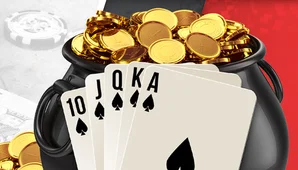
But as we played in those pools, we had to ask ourselves: How do we optimally adjust?
When we solved for it, the answer was that your Aces make more money, but hands like Ace-Three suited don’t. Those hands simply cannot make money when you’re getting three-bet that often — there’s no way around it. If I raise Ace-Three suited and you three-bet me, and I call, that’s not a profitable situation. It’s just not going to make money in the long run.
That’s the situation where, the second you get three-bet, the money that my Ace-Three suited was supposed to be making is gone. I can call or fold — it’s close — and that’s why those hands are basically indifferent. What ended up happening is that we want to be nits… but we can’t be nits, because everyone knows we’re nits.
However, if you’re a nit in the right circumstances, it becomes a very powerful tool.
So, I generally play a normal range — but if there are nits at the table, I’ll play wide. If there’s a maniac or a very aggressive player behind me, I’ll tighten up. Over time, that keeps my image balanced. No one can look at me and say, “He’s a nit.” Even the guy who’s three-betting 20% of hands will have no clue when I’ve switched gears.
So by cherry-picking the right spots to tighten up, being a nit becomes an effective strategic weapon rather than a leak.
Mike: That reminds me of an example from my own poker experience — playing the World Series of Poker Main Event each year. That tournament’s fascinating because it’s full of weak players — which makes it incredibly profitable — but it also attracts the very best in the world.
Sometimes, I’ll find myself seated with two players on my left who have a combined $25 million in live earnings. Meanwhile, I’m a knowledgeable but recreational player compared to them.
When that happens, I immediately adjust my preflop approach. Those marginal opens? They’re gone.
Now, on the other side of the coin — maybe it’s Day 1 of the same event, and the table is full of amateurs. No killers to my left. Suddenly, I’m playing way looser.
So the contrast is huge — and it all depends on table composition and conditions.
But to keep it simple — the takeaway is:
- Analyze the conditions of your situation.
- Think critically about your table dynamics.
Ask yourself:
- “Is this a spot to tighten up and prioritize postflop playability?”
- “Or is this a spot to widen my range and pressure weaker players?”
- “Or is this just a neutral table where sticking to standard strategy works best?”
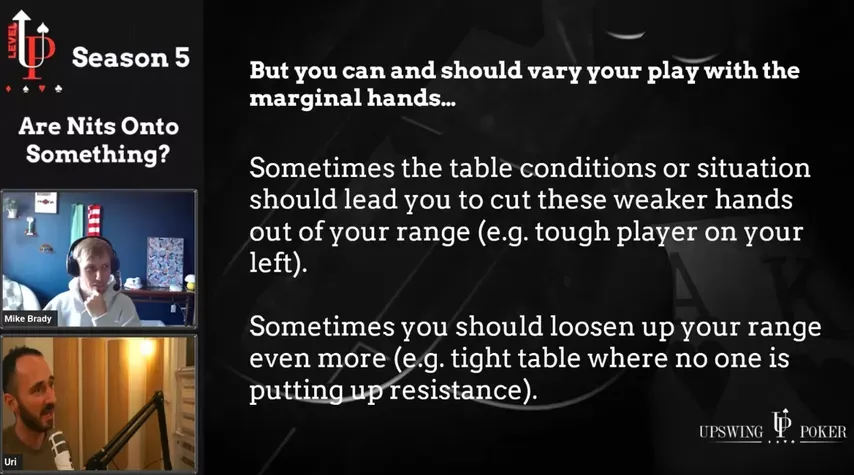
Uri: Yeah, and I think most people understand the idea that if there’s a weak player behind you or in the blinds, you should open wider. That’s just standard.
But the counterpoint is equally important: When there’s a strong player behind you — someone better than you — you should open tighter.
Because now you’re the one at a disadvantage. If we graph your hand EVs, all the marginal hands that were barely profitable before suddenly become losing hands.
It cuts both ways — and that can be tough for people to accept. Especially in tough, international fields, you’ll often face players who simply outclass you. And that’s fine — it’s part of the game. The key is to be aware of it and adjust accordingly.
So, using your offsuit example, something not enough players realize is that you can compensate in two different ways:
- You can open looser
- Or, you can open larger
Those are two sides of the same coin.
So, when you tell me, “Sometimes I open Ace-Five offsuit under the gun,” my response is: that’s generally not going to work. There are five players behind you — it’s very hard to make those marginal hands profitable from early position.
But what can work is adjusting your sizing. For example, you can open to five big blinds under the gun with the range you do play — if you think your opponents will react loosely or call too wide.
A friend of mine who I’ve worked with for years actually studied this in detail. He found that when you’re thinking about opening ranges — say on the button — there’s a threshold where, if the big blind is calling everything, adding more hands stops being profitable. At that point, instead of widening your range further, it’s better to just increase your raise size and make more money with your existing range.
Mike: Got it. Next time, instead of raising A5o, I'll open bigger with A8s.
Uri: Yeah. You don't have to stick to the usual raise sizes; you can boldly expand your horizons. We regulars know what a "reasonable" 3-bet size should be. But if you're playing, say, a Main, you'll run into opponents who have no idea how to raise or 3-bet. I once isolated 98BB after a limp online—simply because the guy didn't care how much he had to pay to see the flop.
Basically, play flexibly! If you see someone eager to see the board, curiosity should kick in: "Okay, so I'm going to raise 5BB instead of 3BB—I wonder if they'll still call?" And if someone always calls three-bets with 97s, will they fold those same 97s when you open-raise to 9BB preflop? Unlikely—they couldn't care less. These spots offer incredible opportunities, and you can win as much as you want.
Mike: So suddenly you flop AK against some random cards, and there are already 21 BBs in the pot...
Uri: Yes, and you can immediately make the SPR comfortable. When you're playing against someone who doesn't care how much they pay, every hand can be turned into art.


Speaking of hands as an art form, if you're not tired of Uri yet, here's a recent anecdote: this summer, he tweeted about his favorite hand of his career:
My favorite poker hand I ever was played with offsuit, before solvers.
In the metagame I was a check-raising maniac with a 30% check-raise because everyone overfolded.
Vs an unknown reg, rainbow, I checkraised my offsuit, and he 3-bet me in position.
I immediately realized nobody would do that for value vs the aggro check-raising redliner maniac. You'd slowplay on the driest board ever.
So I threw in a 4-bet bluff. He called.
Turn , and in my head he has air. I bet 10% to not let him freecard, he raises, I call. River, . He can't have an – he'd have just called the turn! I check-call for stacks and he shows .
The reason I love the hand so much is – a new player who'd just joined the table immediately said "You guys are too crazy for me", got up and left.







